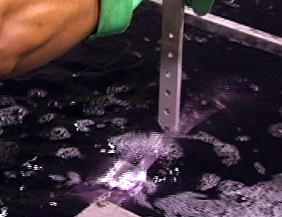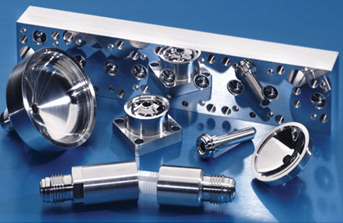Steel
 Is an electrochemical process to grow an attractive and corrosion resistant oxide layer on steel. This is an attractive solution to prevent fresh water staining or corrosion of steel. With additional sealing or top-coating, the anodized layer can reduce saltwater corrosion.
Is an electrochemical process to grow an attractive and corrosion resistant oxide layer on steel. This is an attractive solution to prevent fresh water staining or corrosion of steel. With additional sealing or top-coating, the anodized layer can reduce saltwater corrosion.
Anodized steel is steel that has been given a protective coating to strengthen it and retard the effects of corrosion. While anodized steel may look like many other anodized metals, aluminum in particular, it is not a true anodizing process that creates the steel coating. This is because anodizing involves oxidizing the surface layer of the actual metal itself, which is most often done with aluminum to produce a protective aluminum oxide surface layer. When steel is oxidized, however, the result is to generate a coating of ferric oxide, Fe2O3, more commonly known as rust, which offers little to no protection to the underlying metal and may, in fact, increase the likelihood of the underlying metal layer to corrode. The method that is used to create anodized steel products, therefore, involves coating the metal with other types of anodized metal surface layers based on oxides of zinc, aluminum, or other barrier compounds
A particularly effective method of creating anodized steel is to react it with potassium hydroxide, KOH, or sodium hydroxide, NaOH. Using these chemicals grows a magnetite, Fe3O4, or dichroic magnetite layer on the surface that does offer protection to the underlying steel. While magnetite itself is blue-black in color, dichroic magnetite has an optical effect where a rainbow of colors reflects off of the surface depending on the position from which it is viewed. Often, anodized steel cookware will exhibit this rainbow effect or other anodized products that have some aesthetic value. Though magnetite is closely related to ordinary rust chemically, which sometimes is composed of the compounds lepidocrocite, γFeOOH, or goethite, αFeOOH, it has much more enduring and protective qualities than rust.
 Another method used to create anodized steel is to coat it with oxides of zinc or aluminum. Various types of acids are used in an electrolyte bath to create oxides of the coating metals, from chromic acid to sulfuric acid and boric-sulfuric acid. The steel part acts as the negative anode part of the electric circuit in the electrolyte, and the donor metal such as zinc or aluminum makes up the positive cathode. As current is run through the solution, it, along with the acid base, acts to remove metal ions from the cathode and deposit them on the anode.
Another method used to create anodized steel is to coat it with oxides of zinc or aluminum. Various types of acids are used in an electrolyte bath to create oxides of the coating metals, from chromic acid to sulfuric acid and boric-sulfuric acid. The steel part acts as the negative anode part of the electric circuit in the electrolyte, and the donor metal such as zinc or aluminum makes up the positive cathode. As current is run through the solution, it, along with the acid base, acts to remove metal ions from the cathode and deposit them on the anode.
One of the problems with creating anodized steel is that it is a noble metal that is bonded in the process to metals like aluminum that are un-noble. Since these metals have different corrosion potentials, it is common for the un-noble metal to develop a galvanic layer between the two when bonded together.
